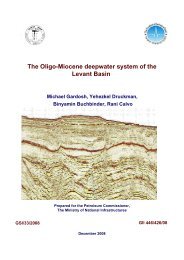tivity on the carmel faul
tivity on the carmel faul
tivity on the carmel faul
Create successful ePaper yourself
Turn your PDF publications into a flip-book with our unique Google optimized e-Paper software.
Seismic events in Denya Cave<br />
Broken speleo<strong>the</strong>ms from Denya Cave yielded break ages that seemed to cluster at<br />
specific times (e.g. ~10-12ka, ~20-24ka, ~29-32ka, ~37-40ka etc. see Table 4 and Figs,<br />
17,18). This indicates that <strong>the</strong> ages are not random and that certain events affected <strong>the</strong><br />
whole cave simultaneously. When c<strong>on</strong>sidering seismite types, each age cluster is also<br />
classified according to its credibility as a precise indicator of a seismic event.<br />
Single sample dating was not possible for Denya Cave seismites and <strong>the</strong>refore criteria<br />
for creating sample age clusters through three-dimensi<strong>on</strong>al isochr<strong>on</strong> plots were<br />
established, yielding a corrected age for all seismite samples of <strong>the</strong> same age. This in turn,<br />
established statistical means to discern ages of seismic events, which caused damage in<br />
Denya Cave. Criteria for viable isochr<strong>on</strong>s are based <strong>on</strong> morphological, special and<br />
chemical factors. Seismic events discerned from Denya Cave seismites, using all<br />
aforementi<strong>on</strong>ed criteria and three dimensi<strong>on</strong>al isochr<strong>on</strong> plots are: 5.03±0.87ka,<br />
10.42±0.69ka, 20.8±3.0ka, 29.1±3.3, 38.0±2.7ka, 57.9±5.2ka, 137±29ka, 147.6±5.4ka<br />
and 160±45ka (Figs. 38, 39).<br />
4.2.2 Isochr<strong>on</strong> age cluster dating<br />
As menti<strong>on</strong>ed above, all seismite samples that plotted <strong>on</strong> isochr<strong>on</strong> lines were used for<br />
age calculati<strong>on</strong>s. In this study <strong>the</strong> criteria for establishing a reas<strong>on</strong>able isochr<strong>on</strong> (see ch.<br />
3.3-Age cluster dating) encompass not <strong>on</strong>ly geochemical criteria, but also take into<br />
account structural features within <strong>the</strong> cave and stratigraphic c<strong>on</strong>siderati<strong>on</strong>s in <strong>the</strong><br />
speleo<strong>the</strong>m sample laminae.<br />
Table 7 shows that calculati<strong>on</strong>s using isochr<strong>on</strong>s give average ages, causing some<br />
samples to appear older, whereas a single correcti<strong>on</strong> would always cause <strong>the</strong>m to be<br />
younger (e.g. correcti<strong>on</strong> factor 1.8 ; Table 7). Essentially this means that <strong>the</strong> ages of<br />
sample clusters are <strong>on</strong>ly significant when <strong>the</strong> samples are c<strong>on</strong>sidered as a group. Since <strong>the</strong><br />
sampling technique is not as accurate as <strong>the</strong> actual results from <strong>the</strong> MC-ICP-MS, it seems<br />
reas<strong>on</strong>able that any age of a seismic event obtained from this kind of research would<br />
result from averaging individual sample ages.<br />
When using three dimensi<strong>on</strong>al isochr<strong>on</strong> calculati<strong>on</strong>s all samples are c<strong>on</strong>sidered, even<br />
those o<strong>the</strong>rwise discarded because of <strong>the</strong>ir high detrital c<strong>on</strong>tent. Those samples add to <strong>the</strong><br />
number of samples included in <strong>the</strong> average and yield more accurate ages because <strong>the</strong>y<br />
better c<strong>on</strong>strain <strong>the</strong> isochr<strong>on</strong> line.<br />
65

















